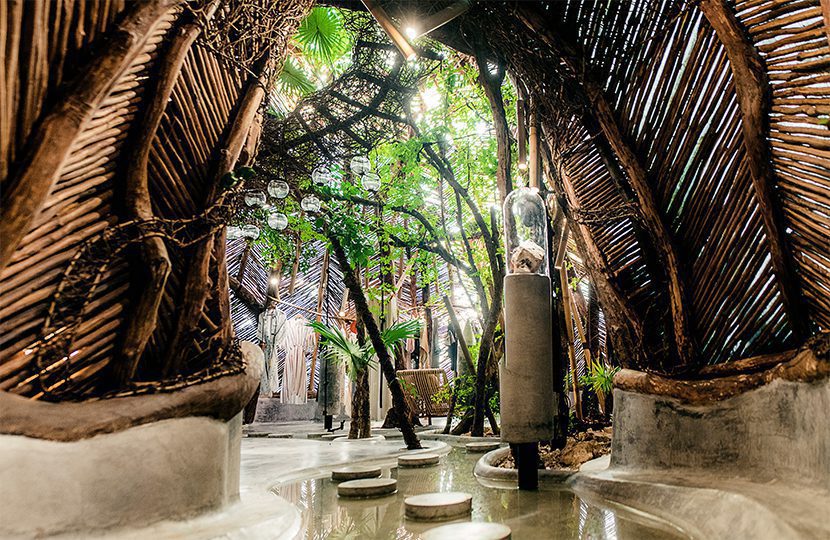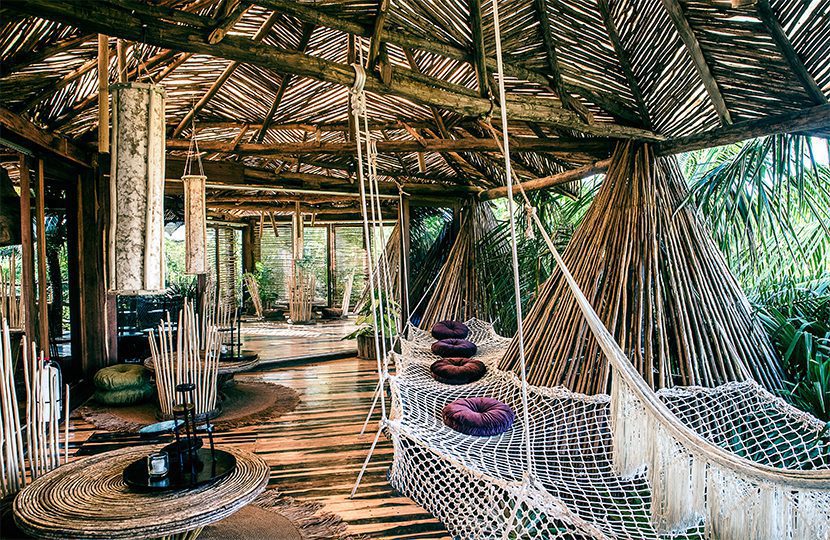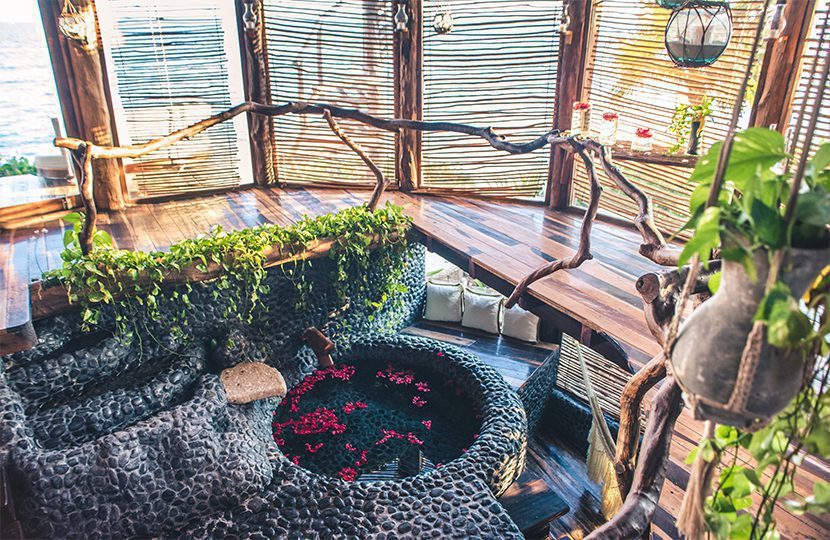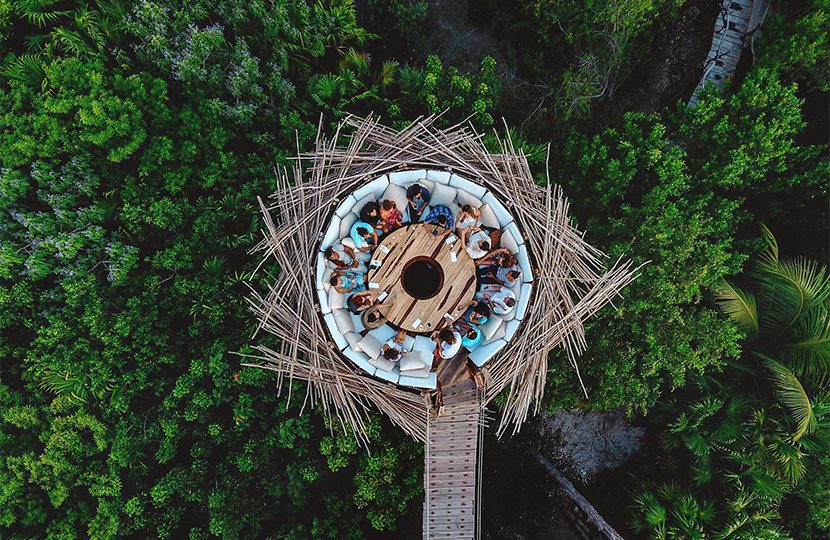In Tulum, Mexico, structures made from bejuco vines, plants local to the area, rise from the jungle. A strip of villas skirting treetops look out at turquoise sea. Frothy waves lap white sand below. This is eco-resort Azulik.
[vc_row][vc_column width=”1/4″][vc_separator color=”black” border_width=”10″][vc_custom_heading text=”Tulum, Mexico”][vc_separator color=”black” border_width=”2″][vc_widget_sidebar sidebar_id=”sidebar-page”][/vc_column][vc_column width=”3/4″][vc_column_text]In Tulum, Mexico, structures made from bejuco vines, plants local to the area, rise from the jungle. A strip of villas skirting treetops look out at turquoise sea. Frothy waves lap white sand below. This is eco-resort Azulik.
Its story starts 20 years ago with Argentinean-born artist Jorge Eduardo Neira Sterkel. While on a sailing trip through the Caribbean, he discovered the town of Tulum and decided to stay. He was a painter and, through the sales of his paintings, was able to purchase land. Without any formal architectural training, he began construction on Azulik.
“I never plan a thing. I never make floor plans,” he says. “A plan does not work if you want to respect nature.”[/vc_column_text][/vc_column][/vc_row][vc_row][vc_column][vc_column_text]
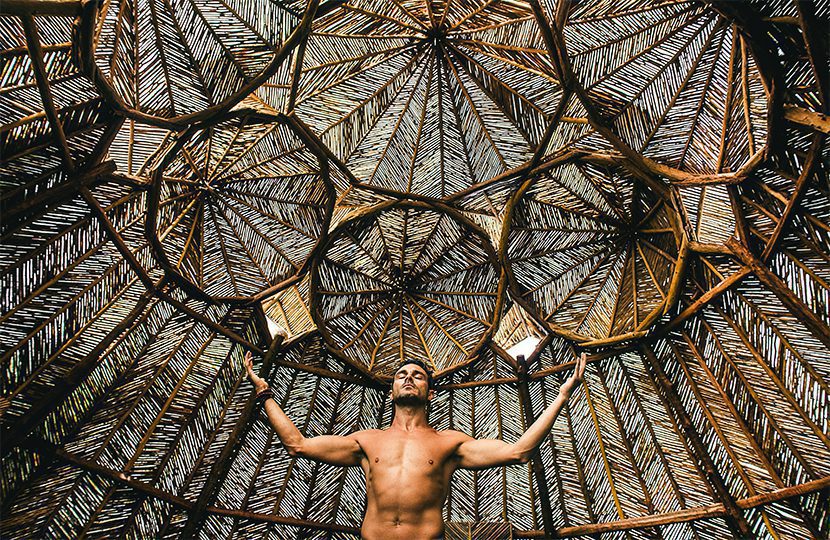
Domo para ceremonias Maya Spa
[/vc_column_text][/vc_column][/vc_row][vc_row][vc_column width=”1/4″][/vc_column][vc_column width=”3/4″][vc_column_text]
Structures at Azulik are built with the same materials Mayans have used for centuries, bejuco and wood, all collected from the area. The first few villas were built in the same ways too – oval-shaped and with thatched roofs.
“The funny thing of the process is that we never know what we will do. Even if I have a previous idea, nature imposes herself. If it can’t be done in a known way, then the answer is to play, to improvise.”
Sterkel works with a team of 200-or-so modern Mayans and describes them as playful and mischievous. ‘It must be something never seen before,’ I tell them, and they laugh as kids planning a trick. When the idea appears, they work to bring new answers.”
Today, trees spring up from the middle of wood walkways. In the villas, sunlight filters through slivers between vine ceilings. There are no phone lines so room service orders are scribbled onto scraps of paper, which are then placed in wooden balls and dropped down a shoot leading to the kitchen.
Sterkel’s plan – or rather, lack thereof – has worked. Nature has not only been respected, but it’s being benefited from too. The water used throughout the resort comes from cenotes, sinkholes the area is known for, and is rich in minerals. No electricity means calming candlelight and no distractions.
For guests at Azulik, a restored connection with the environment, with others and with themselves is inevitable – exactly as Sterkel intended. “That is the purpose of Azulik: to reconnect individuals and tribes,” he says.
From eight villas in 2003, Azulik now has 48. The Jungle, Mayan and Aztec Villas nestle into greenery while the Sea and Sky villas sit seafront. Though the resort is luxurious, it still retains Tulum’s free-spirited ethos with a clothing-optional private beach and mosaic bathtubs replacing showers.
[/vc_column_text][/vc_column][/vc_row][vc_row][vc_column][vc_column_text]
“The idea behind this is for you to take your time, soak in the tub with bath salts and relax. The shower is an invention of rushed men,” reads its website.
A spa, hair salon, clothing store, apothecary and three restaurants – Kin Toh, Tseen Ja, and Cenote – have also since sprouted up around the property. An eyewear shop is set to open later this year.
It’s the resort’s contemporary art gallery IK Lab however that has garnered the most attention. Opened on April 20th this year, it’s brought Azulik into the architecture world’s spotlight. And while it may have been the gallery’s director Santiago Rumney Guggenheim, the great-grandson of famed art collector Peggy Guggenheim, who gave media outlets their headlines, it was the actual space that had people captivated.
The collaboration came about organically. Guggenheim had recently moved to Tulum and was walking around town when he saw a property with a big round door from the road. Intrigued, he asked to meet its owner. The door was one of Azulik’s and the result of their meeting was IK Lab.
[/vc_column_text][/vc_column][/vc_row][vc_row][vc_column][vc_column_text]

Casa de la medicina ancestral (Apoteca)
[/vc_column_text][/vc_column][/vc_row][vc_row][vc_column width=”1/4″][/vc_column][vc_column width=”3/4″][vc_column_text]
“End of April, in the heart of one of the most exclusive locations in South America, an unprecedented art gallery project will be launched,” Guggenheim announced on his Facebook page at the time.
In the Mayan language, ‘ik’ means wind – a fitting name for the gallery’s undulating floors, walls and ceilings. Guests enter through a 4m-high round glass door and, once inside the cavernous space, are requested to remove their shoes. Sunlight spills in through round windows, warming the wood floor. In other parts, the floor is cold and concrete.
“The space is the perfect conversation between nature and human-made, the smooth surface of the concrete alternated with the curves of the raw bejuco,” says Gallery Manager Valentina Bizzotto. “It reminds me also a bit of Antoni Gaudi.”
The gallery is made from wood and fiberglass and has a live tree incorporated into its structure. Everything is handmade and, as a result, susceptible to nature’s elements – like rain.
“Of course we might have some water coming in from the door. Or sometimes the wood expands with the humidity and cracks the fiberglass so we might have a bit of leaking,” says Bizzotto.
“But then the day after, we fix the fiberglass and it’s not a big deal. But it’s very beautiful because the rain here lasts usually one hour and is very strong. You feel so safe in the gallery and the noise is amazing.”
[/vc_column_text][/vc_column][/vc_row][vc_row][vc_column][vc_column_text]
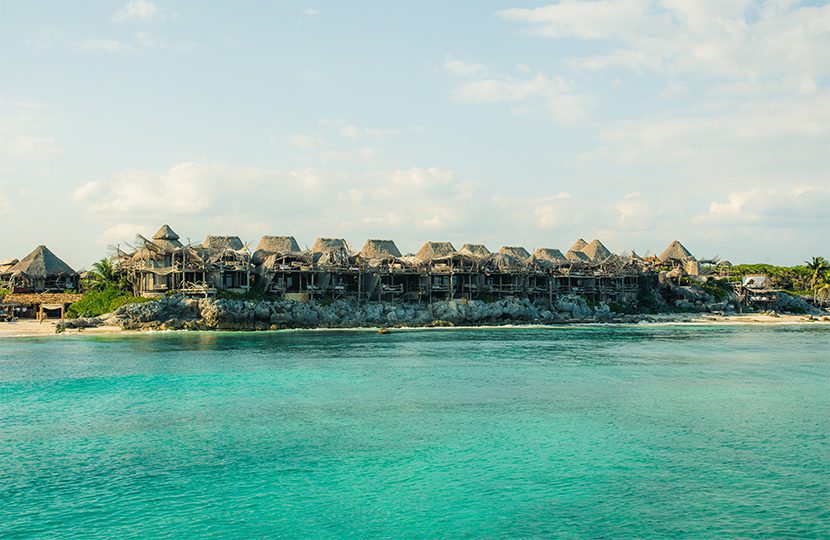
Sea Villas on the first floor and Sky Villas on the second floor sit ocean-front
[/vc_column_text][/vc_column][/vc_row][vc_row][vc_column width=”1/4″][/vc_column][vc_column width=”3/4″][vc_column_text]
The gallery’s inaugural exhibition Alignments features 20 works by international artists Artur Lescher, Margo Trushina and Tatiana Trouvé that explore the human journey through physical and metaphysical realms. The artworks seem to belong to the space. So much so that walking through the gallery, it’s difficult to discern where the gallery ends and Alignments begins.
It’s something Tulum as a whole does well – blending art with its surroundings. Less than two decades ago, the town, located 90 minutes south of Cancun on the Yucatan Peninsula, was only a small hippie community. The hashtagging of its creative, colourful restaurants, environment-embracing hotels and jaw-dropping cenotes has helped to grow it to what it is today.
Its downtown Pueblo area, filled with taco joints, souvenir stalls and dive shops, sits inland. Cenotes dot its side streets. A 15-minute drive to the coast takes you to the town’s ritzier resort zone where you’ll find Azulik. Sprawling, seaside hotels sit on one side of the winding road leading through the jungle. Restaurants and shops, seemingly carved into the jungle, are on the other.
With the stream of tourists multiplying every year, the town is expanding rapidly as it tries to keep up. It’s a similar situation within Azulik. On his 126-hectare slice of jungle, Sterkel says he has plans to add a museum, a recording studio, artist residences, a spa hotel and a wellness hotel.
It certainly seems as if for Sterkel, the sky is the limit. It’s ironic then that his only obstacle is buried deep into the ground. “The one and only rule is not to cut any trees,” he says. ◼
[/vc_column_text][vc_basic_grid post_type=”ids” element_width=”12″ initial_loading_animation=”none” grid_id=”vc_gid:1542283030075-73c9cf4a-b0a3-7″ include=”14575″][vc_column_text]
Subscribe to the latest edition now by clicking here.
© This article was first published in Aug-Sept 2018 edition of World Travel Magazine.
If you would like to comment on this story or anything else you have seen on World Travel Magazine, head over to our Facebook page or message us on Twitter.
And if you liked this story, subscribe to our bi-monthly World Travel Magazine, a handpicked selection of editorial features and stories from Global Destinations, Inspire Me, Insider, Style File, Wellness & Travel, City Travel, Suite Life, At Leisure, Short Breaks and much more.[/vc_column_text][/vc_column][/vc_row][vc_row][vc_column][vc_masonry_grid post_type=”post” max_items=”9″ style=”load-more” items_per_page=”9″ gap=”10″ grid_id=”vc_gid:1542283030083-70b941a8-4271-5″ taxonomies=”1628″ exclude=”15205, 14466, 11296″][/vc_column][/vc_row]


